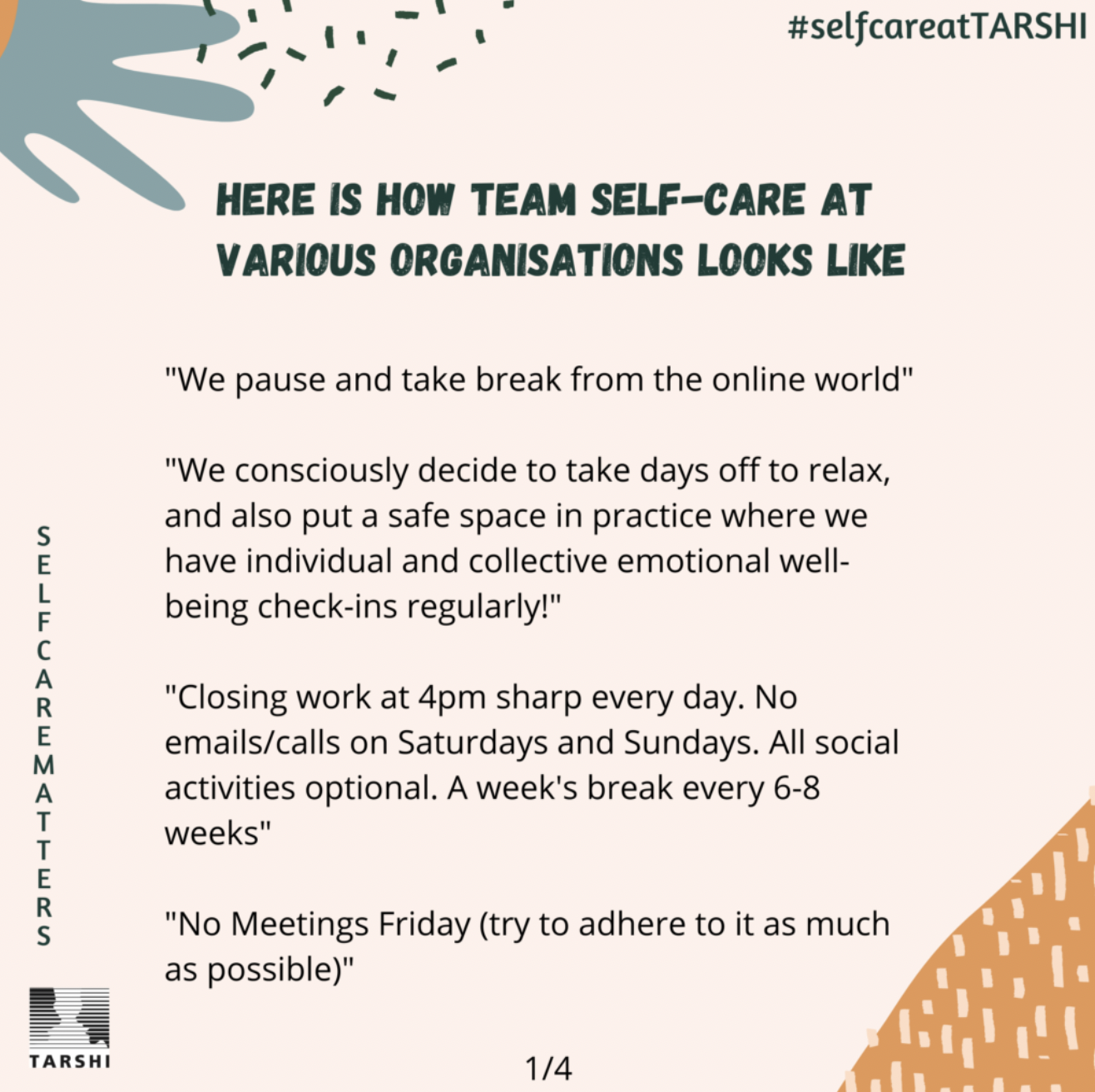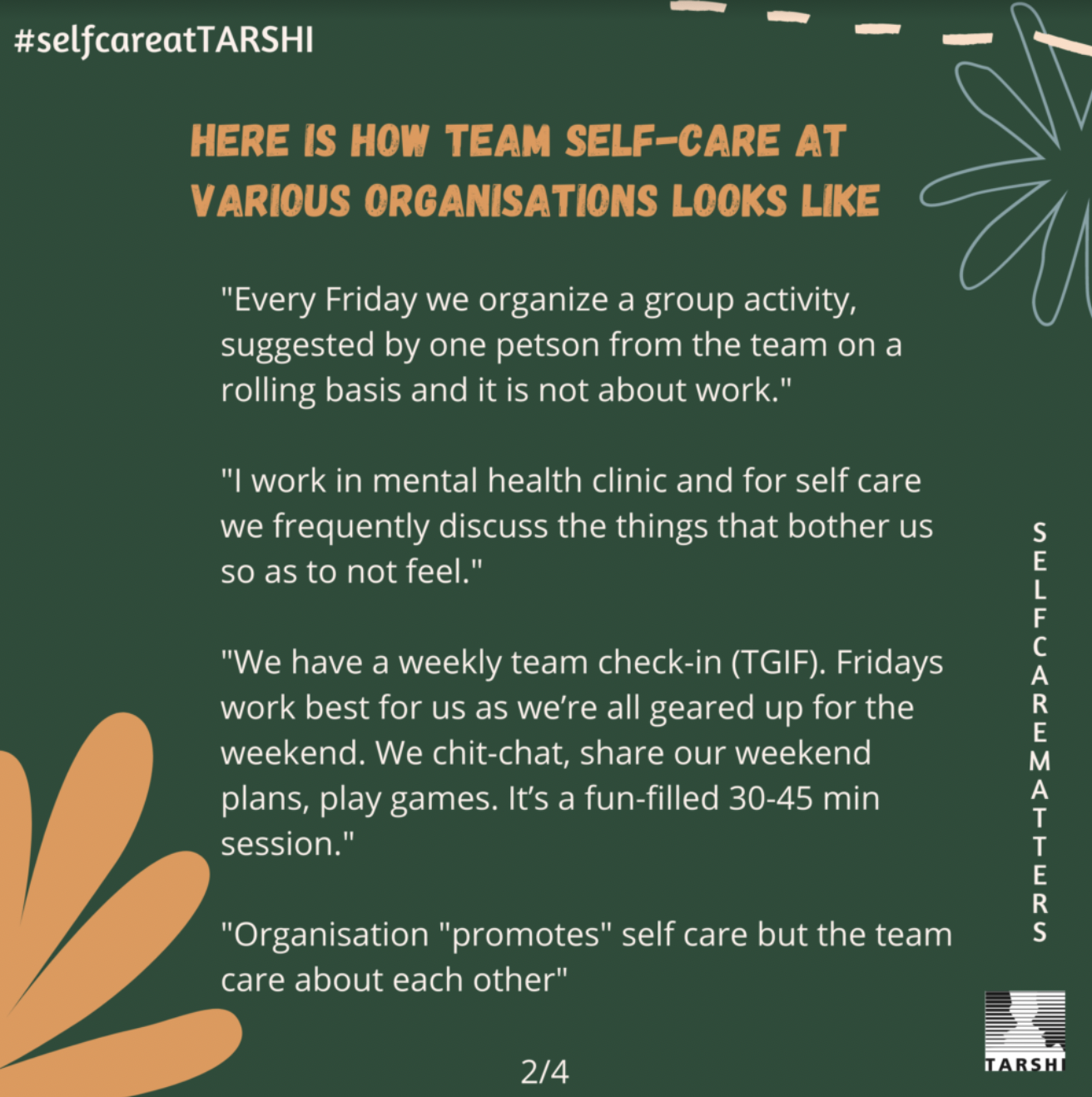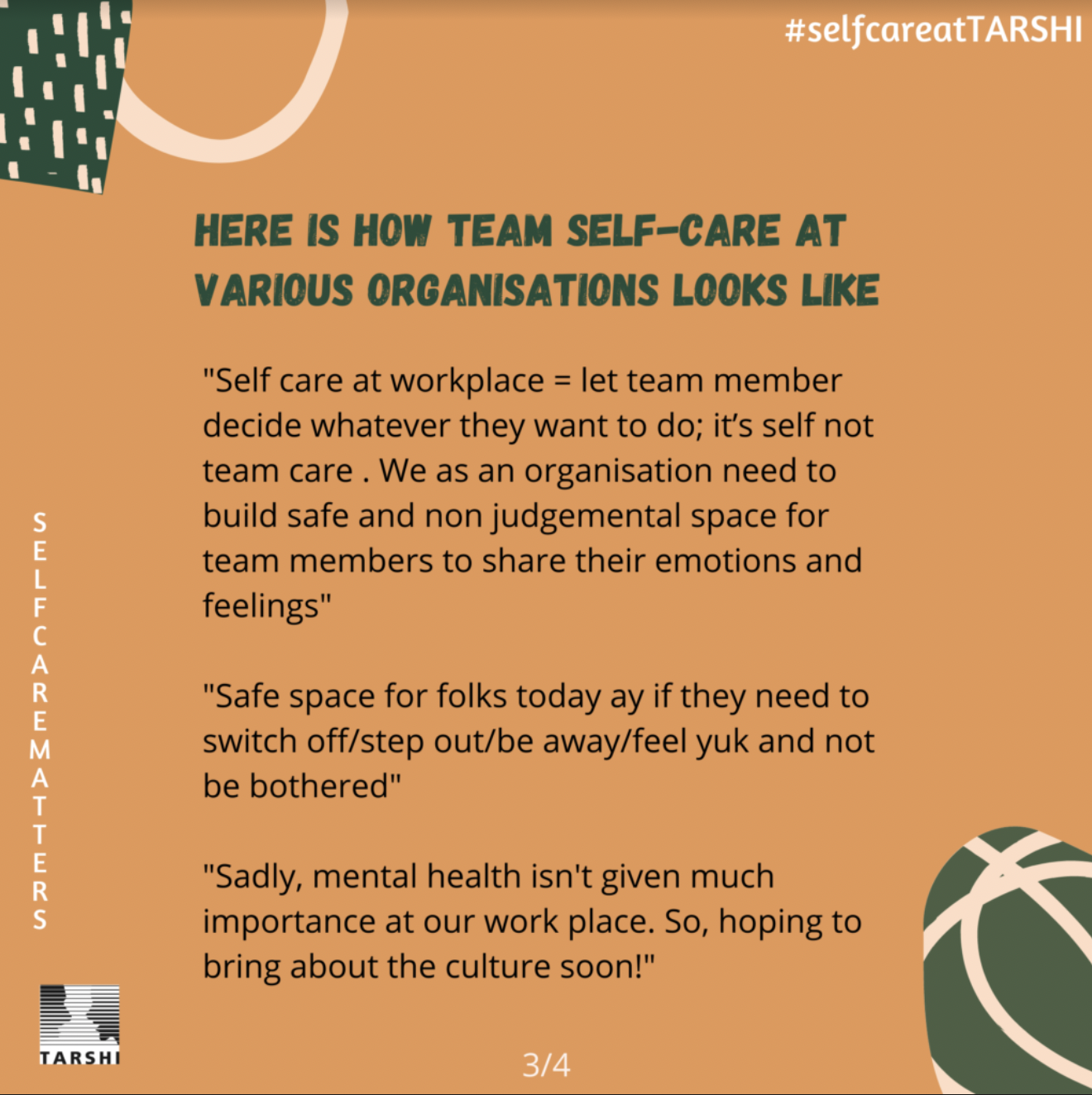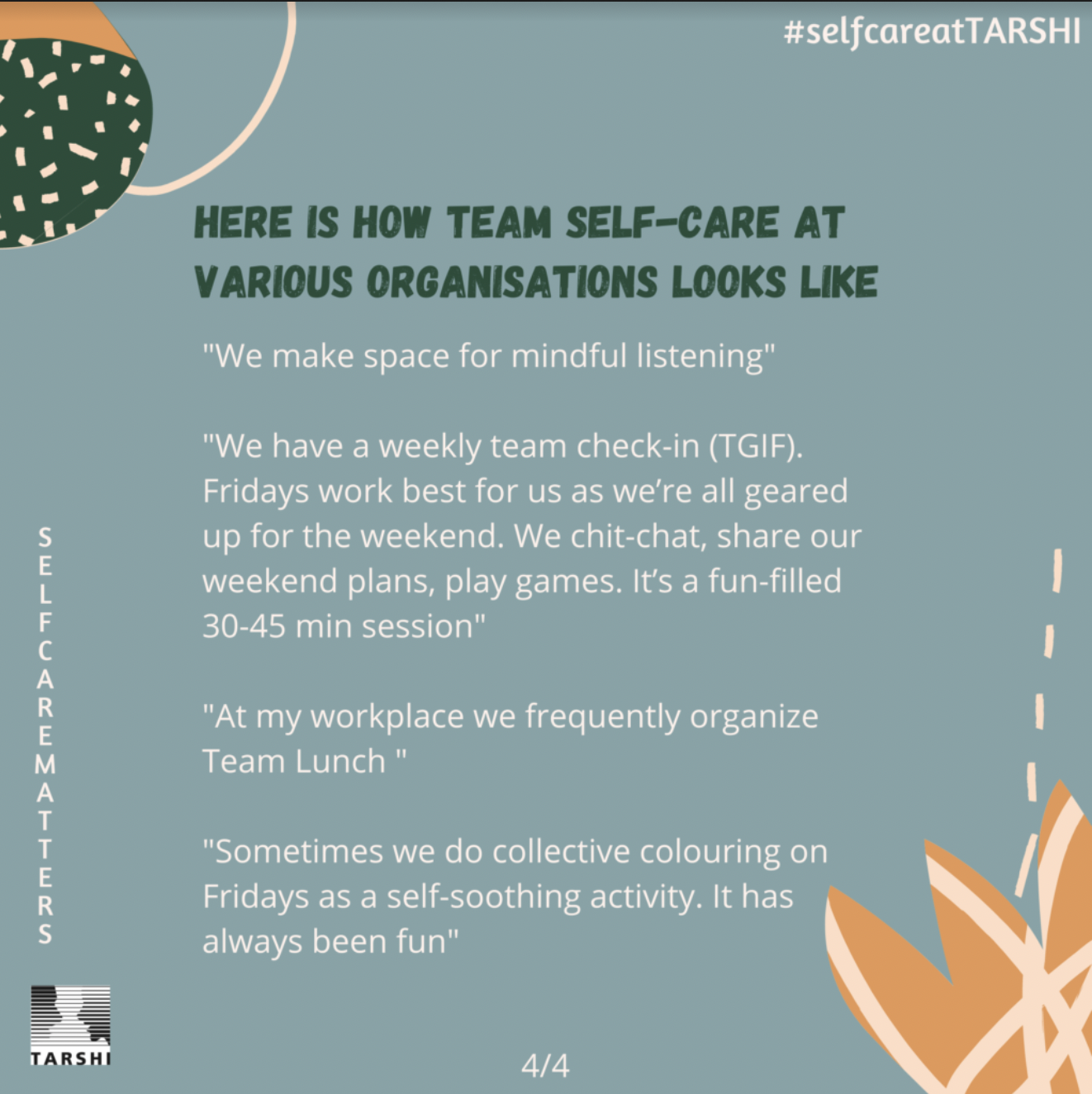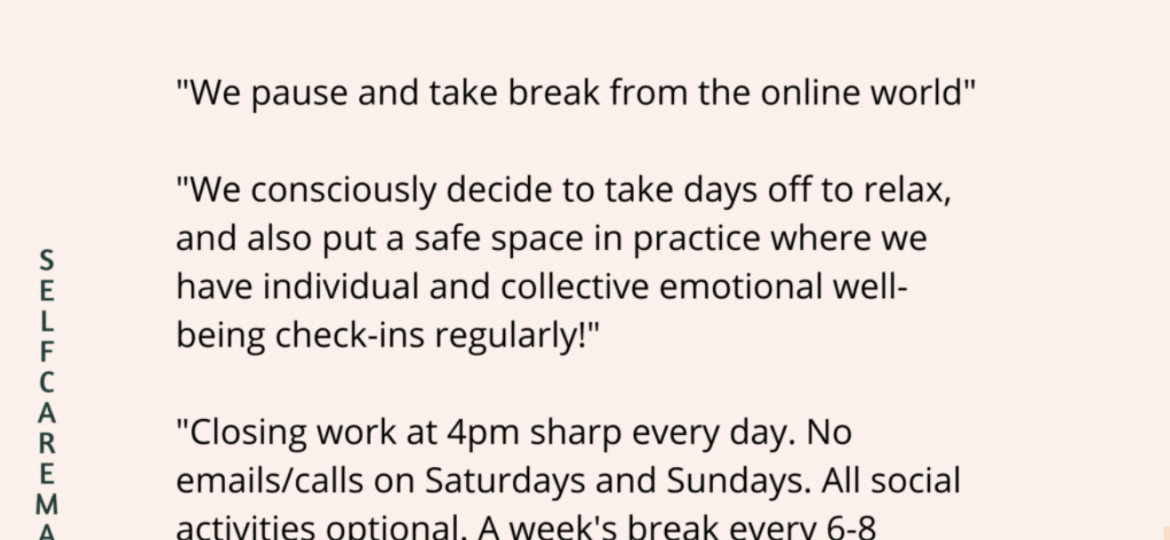
In March 2020, the national lockdown in India due to the Covid-19 pandemic pushed people headlong into uncertainty, forced many organisations to work-from-home mode, and – in essence – created conditions that tested everyone’s mental health. There was much to be anxious about: health, finances, safety at home, job security, loneliness, being cut-off from loved ones, seeing/hearing/reading about hardships being faced by people around us, having to suddenly take on more household work, seeing education disrupted, and having to communicate with others entirely on-screen (and in many cases, being completely cut-off from people who were not online).
As the enormity of the mental health crisis revealed itself, for perhaps the first time, there were serious efforts from State and non-State organisations to address people’s mental health through helplines, counselling, and listening circles. The mental health needs of people doing people work, such as health service workers, NGO staff, therapists and counsellors, and even teachers, also began to get the attention they deserve.
However, in a country where talking about or seeking support for mental health is taboo, these efforts barely scratch the surface of the actual need. Besides, few of these solutions acknowledge that one’s mental health is not just about one’s self, but also the institutions and systems one is a part of. And that therefore, maintaining mental health and wellbeing is not only about individual efforts, but also about these institutions and systems.
Stress management and burnout prevention have been integral to TARSHI’s work since our inception in 1996 as a helpline offering information, counselling and referrals on issues related to sexuality. We were (and are) mindful that working on sexuality from a pleasure-affirming perspective, even while we live in societies that are yet to affirm sexual and reproductive rights of all individuals, has the potential to cause stress, dissonance, distress, and burnout. This led us to incorporate techniques on, and build an environment that facilitates burnout prevention and self-care. Over the years we have evolved this work further to talk about self-care, stress management and burnout prevention among those of us who do people work. In 2020 we engaged in even more of these activities, while also taking care of ourselves. Here’s a short roundup of our work and what we’ve learnt along the way!
Team self-care at TARSHI and beyond
Team self-care, that is a space for team members to practice self-care, has been a part of our workspace since our early days, and the pandemic times (we’re just going to broadly refer to 2020 and 2021 this way!) have been no exception. We meet once a week to gather ourselves and our thoughts, to reflect on how we feel that day, and work to feel better. For a few weeks, we focused on trying a variety of techniques, each of us sharing something that worked for us with the rest of the team; soon, we had tried guided meditation, various forms of energy medicine, art-based techniques, journaling, and more! As we tried these, we learnt something new – the technique itself, perhaps, but also something about ourselves. How do I gauge how I feel at the moment (challenging, sometimes, but we have the SUE scale that helps us)? How do I know what works for me, and when? Over time, we have been able to tap into our palette of techniques when we gather once every week to practice team self-care, and sharing our experiences and thoughts with each other (to the extent we’re comfortable doing so) has helped us enormously. In 2020, we shared some of these techniques, and the experience of a team member who particularly enjoyed or benefitted from that technique, as part of a social media activity. Find these posts here!
The response to this campaign got us thinking: what do other organisations do for team self-care or collective care, that is, looking at wellbeing as something that all members can shape together? We asked on social media in the run up to International Self-care Day on July 24 (in 2020) and here’s what we got. We’re aware that collective care has been tougher during the pandemic, especially given remote work and various uncertainties, but it’s heartening to know that many of us in people work are trying our best to facilitate such spaces in our teams!
A website with self-care resources for people doing people work
A self-care toolkit that we’d envisaged for participants of our workshops on stress management and burnout prevention took a turn when the workshops had to be put on hold thanks to the pandemic. With work-from-home and increased online conversations on mental health, we thought: “Why not convert that physical toolkit we planned to give workshop participants into an online one?”
Thus was born Self-care Essentials!
We began populating the site with several worksheets we had used in our stress management and burnout prevention workshops, and along the way created some new ones too. We tested every worksheet with our team to ensure the questions were clear, and to gauge how much of the heart/mind/body was needed for the worksheet, the level of seriousness, etc. so that we could add these to every worksheet to help a potential user gauge whether they were in the right frame of mind to do it then.
We also curated many resources for the site, which was an exciting project of its own! That meant we had to read many articles, documents, guides, and more, to see whether they matched our perspective of self-care and wellbeing as a right and to gauge their fit with the other contents of our site. But it was not all serious business; there was a lot of fun too (see Timepass, for instance)! If anything, as we worked on the site, our bigger challenge was to balance our desire to add more (there is so much to cover!) with not overwhelming a visitor to the site.
For the team working on the website, it was a steep learning curve to figure out the workings of WordPress and to learn to upload the visuals, text, forms and videos. The team met nearly every day to discuss progress, challenges, and questions. Doing all this remotely, with a pandemic raging around us, was rather challenging but also invigorating. We also made sure to check in on each other and take on work from the other when they were feeling overwhelmed, whether it was with the work or life circumstances.
When we launched Self-care Essentials on December 2020, after an intensive internal and external review process, we were grateful to have been able to put together a one-stop centre for resources for self-care, collective care, and more. Developing Self-care Essentials was a soothing, learning experience, and we hope you find it the same – give it a go at tarshi.net/selfcare!
Creating an online course on stress management and burnout prevention
With the pandemic putting a brake on a series of workshops we had planned on stress management and burnout prevention, we explored webinar-led workshops spread over a few days, but finally decided to use our years of experience in online courses (since 2011!) to develop a short online course instead.
We wanted the online course to take on organically from Self-care Essentials, but also be more intensive in its approach, helping learners understand stress and burnout conceptually but also reflect on how these manifest in their own lives. We also wanted learners to consider their unique causes of stress – how their sexuality and their various identities could contribute to stress – as part of thinking about how they could prevent or manage their stress. Finally, we wanted to ensure that managing stress or preventing burnout was not seen as only an individual’s responsibility. As such, the course would help the learner examine their multiple sources of stress – individual, institutional and systemic, and emphasise collective care in addition to self-care as part of stress management and burnout prevention.
True to all that we wanted the course to help learners do, we named it ‘Reflect, Realign, Renew: Manage stress and keep burnout away’!
While some parts of the course got done quickly, the last section on helping learners create their own menu of practices to manage stress and prevent burnout was especially challenging since we would have approached it differently if it were an in-person workshop. We would have shared a variety of tools, have participants share their experiences and learn from each other. For the online course, we realised that learners would expect concrete suggestions on various aspects of stress management, such as ways to be aware of and express one’s emotions, what it means to be part of a safe space, how collective care pans out, and more. We experimented with many ideas before finalising what we thought would appropriately fit in a short course. We had to again be mindful of not giving too much information that would overwhelm the learner.
Developing the content led the team members to have many intense discussions as we learnt how to articulate our thoughts better or challenge our biases on these topics. How well do we explain that seeing “some stress as good” is not a useful framework? How do we ensure that we take into account issues of diversity (gender, sexual identity, education, disability, marital status, class, religion, profession, location, caste, and more) as we explain factors that cause stress? At many points, we found ourselves learning, unlearning and being challenged. It was especially interesting to work on this course during the pandemic, as we found solace in the content we were creating (and trying to remind ourselves of key messages from the course for our own mental health), but also because we were glad to bring these discussions to an online learning platform.
This was also TARSHI’s first video-led course, and making these videos was a new, exciting challenge in its own right! Since we had decided to go with visual imagery (and not a person talking), we used a range of elements to represent the course content. We had to be careful not to use elements that were stereotypical on the lines of gender identity, class, skin colour, body type, disability status, and so on. Given the course is on stress management and burnout prevention, we also wanted to ensure the look and feel of the interface, videos, infographics and all other content, was soothing, minimal and easy on the eye. Since the content/exercises could get ‘heavy’ at times, we peppered the course with many energisers encouraging the learners to take a break.
We are so excited that we’ll be able to share this course with you soon. Read this to know more about the course and to be informed when the course is out!
The pandemic has put us through interesting times, to say the least – of reflecting, learning, realigning, thinking about what really matters, a time to pause and care for ourselves with kindness. At TARSHI, we’re just delighted to have been able to do the same – while also sharing something of what we’ve learnt with you.
Thanks to Nalini Sharma, Nidhi Chaudhary, Prabha Nagaraja and Ramya Anand from TARSHI for their inputs!
इस लेख को हिंदी में पढ़ने के लिए यहाँ क्लिक करें।
